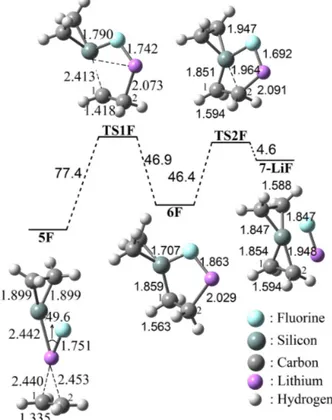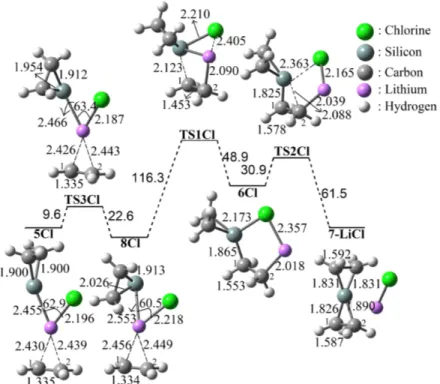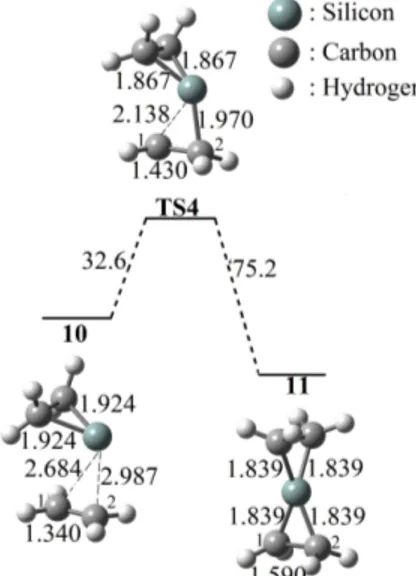.
The article was published by ACG Publications
www.acgpubs.org/OC/index.htm © January-March 2018 EISSN:1307-6175 DOI:http://doi.org/10.25135/acg.oc.36.17.07.043
Cycloaddition reactions of silacyclopropylidenoids to ethylene
Cem B. Yildiz
,1,2and Akın Azizoglu
,2*1Department of Medicinal and Aromatic Plants, University of Aksaray, 68100 Aksaray, Türkiye 2Laboratory of Computational Chemistry, Department of Chemistry, University of Balikesir, 10145
Balıkesir, Türkiye
(Received July 31, 2017; Revised August 25, 2017; Accepted August 26, 2017)
Abstract: The cycloaddition reactions of silacyclopropylidenoids (C2H4SiXLi, X = F, Cl, Br) to ethylene have
been investigated separately to gain insights into halogen and solvation effects on the energetic of the proposed reactions at the B3LYP/6–311+G(d,p) level of theory. The calculations reveal that the addition of silacyclopropylidenoids to ethylene occurs via stepwise mechanisms. The required initial energy barriers for the conversion of silacyclopropylidenoids to silaspiropentanes are determined to be ΔG = 77.4 kJ/mol, 9.6 kJ/mol, and 9.2 kJ/mol for F, Cl, and Br, respectively. Furthermore, the gas phase calculations show that the reactions are not spontaneous at room temperature, whereas those of THF solvated models indicate that the formations of silaspiropentanes are spontaneous in the cases of X = Br and Cl. Additionally, the findings show that the silacyclopropylidene addition to ethylene is determined to be exergonic in both gas and THF phases by ΔG = – 42.6 kJ/mol and –39.3 kJ/mol, respectively.
Keywords: Silacyclopropylidenoids; silylenoid; silaspiropentane; reaction mechanism; DFT. ©2018 ACG Publications. All rights reserved.
1. Introduction
Carbenoids are compounds which have an electropositive metal and halogen are bound to the same carbon atom and have been known as highly reactive carbon species in organic chemistry.1–3 The
silicon analogue of simple carbenionds, H2SiLiX, X = F, Cl, or Br,4,5 are most often key intermediates
in many organometallic and organosilicon reactions and having considerable attention due to their applications to experimental and theoretical fields.6–11 In 1995, Tamao and Kawachi explored the
existence of a silylenoid and examined its chemical properties.11 However, only limited stable
silylenoids have been characterized up to now because of their highly reactive nature. A number of halosilylenoid compounds from the reaction of TsiSiX3 [Tsi = C(SiMe3)3, X = Br, Cl] with lithium
naphthalenide were published by Lee et al.13 Apeloig et al. disclosed formation of fluorosilylenoid
from the reaction of bromofluorosilane with silyl lithium in 2006.12 Despite considerable potential in
this regard, 9,14,15 reports on those of cyclic analogues (C
2H4SiLiX, X = F, Cl, or Br) are still rare.16–18
Very recently, we have performed a series of theoretical calculations on the formation and rearrangement of silaspiropentane 2 from addition of lithium–bromosilacyclopropylidenoid 1Br to ethylene (Scheme 1).18 The nature of the addition reaction of 1 to ethylene is found to be endergonic
by ΔG = 33.9 kJ/mol, whereas the formation process of 4 is exergonic by ΔG = –60.6 kJ/mol at the B3LYP/6–31+G(d,p) level of theory.
*
Scheme 1. General representation of the proposed intermolecular addition of 1Br to 2 and intramolecular rearrangement of 2 to 3 and 4.
In the present computational study, we would like to distil a general message for the effects of halogen and solvent (Tetrahydrofuran, THF) on the possible cycloaddition reactions of silacyclopropoylidenoids (C2H4SiLiX, denoted as 1X with X = C, Si, or Ge) to C=C double bond of
ethylene. As we will show, the reactions proceed in stepwise manner in all case. The nature of the reactions is shown to depend heavily on the phase (Gas or THF) and halogen (X = F, Cl, or Br) of the calculations.
2. Experimental
All the computations were carried out by Gaussian 09W packed program.19 , Density
functional theory (B3LYP with 6–311+G(d,p) basis set) was employed to locate the studied compounds on their potential energy surface. The optimized structures were determined by characterization of their Hessian matrix as a minimum (no imaginary frequency) or transition state. The intrinsic reaction coordinate (IRC) procedure was carried out for the identification of the connectivity of stationary points on the respective potential energy surfaces with the algorithm of Gonzalez–Schlegel.20,21 The frequency calculations of THF (Tetrahydrofuran) solvated models have
been done for the optimized structures with using polarized continuum model (PCM) solvation model to estimate solvent effect on the energetic of the reactions.22 The optimized structures were visualized
by using the GaussView 3.0 program.23
3. Results and Discussion
Hence, we have started optimization of most stable S form of C2H4SiLiX from
silacyclopropylidenoid (S), tetrahedral (T), and inverted (I) forms (Scheme 2).24
Scheme 2. The silacyclopropylidenoid (S), tetrahedral (T), and inverted (I) forms of C2H4SiLiX
(where X = F, Cl, Br).
Then, the S forms with F, Cl, and Br are selected as reactant for the proposed reactions and those of van der Waals complexes (5F, 5Cl, and 5Br) are optimized on their potential energy surfaces (PES) at the B3LYP/6–311+G(d,p) level of theory (Figure 1–3). The C1–Li and C2–Li bond distances of 5F are determined to be 2.440 Å and 2.453 Å, respectively (Figure 1). As the addition reaction continues, TS1F is formed by ΔG≠ = 94.6 kJ/mol. The theoretical computations indicate that the C2 atom of the
ethylene unit becomes connected (2.073 Å) to counter ion Li+ and the Si atom of the
silacyclopropylidenoid moiety moves to the C1 atom to form a related TS1F structure along the potential energy surface. As it can be seen from Figure 1, the C2–Li bond distance in TS1F is considerably shortened as compared to that of 5F (2.433 Å), whereas C1–C2 bond length in 5F is elongated with 0.083 Å. The geometry changes along with TS1F promotes formation of 6F. The calculated energy barrier from 6F to TS1F was obtained to be ΔG≠ = 46.9 kJ/mol. A newly formed σ–
is decidedly endergonic by ΔG = 72.3 kJ/mol (Figure 1). Collectively, the mechanistic pathway of 1F is appeared to bear a reasonable resemblance to our previous report on 1Br reaction.18
Figure 1. The proposed addition reaction mechanism of 1F to ethylene.
The exchange of the halogen atom with chlorine and bromine (X = Cl or Br) has a minor mechanistic impact: instead of two steps mechanisms now three steps processes via 8X (X = Cl or Br) lead to silaspiropentane compound. The initial required energy barriers to 8X (X = Cl or Br) are determined to be very similar by ΔG≠ = +9.6 kJ/mol and 9.2 kJ/mol, respectively (Figure 2 and 3). The structure 8X
can be described as distorted form of 5X with the obtained structural properties. For instance, the C1– Li (2.456 Å) , C2–Li (2.449 Å), and C1–C2 (1.334 Å) bond lengths in 8Cl are determined to be very similar as compared to those of in 5Cl (2.430 Å, 2.439 Å, and 1.335 Å), respectively (Figure 2). The required energy barriers for the coordination of Si and Li+ atoms to the C1 and C2 atoms to form
related intermediates 6X via TS1X were calculated to be ΔG≠ = 116.3 and 119.3 kJ/mol for X = Cl
and Br, respectively. The intermediates 6X follow cyclization step to form 7–LiX complexes via TS2X by ΔG≠ = 30.9 kJ/mol for Cl and 30.1 kJ/mol for Br. The results indicate that formations of 7–
LiCl and 7–LiBr are endergonic by 23.8 kJ/mol and 27.3 kJ/mol, respectively. Thus, the gas phase calculations at room temperature suggest that the reactions are plausible but not spontaneous at room temperature.
Figure 2. The proposed addition reaction mechanism of 1Cl to ethylene.
Figure 3. The proposed addition reaction mechanism of 1Br to ethylene.
We also calculated the possible mechanism of the cycloaddition reaction between silacyclopropylidene 9 and ethylene to evaluate effect of LiX. DFT calculations on the mechanism predict free energy barrier of ΔG≠ = 32.6 kJ/mol for TS4 after formation of van der Waals complexes
10, so that the overall pathway for 11 is decidedly exergonic by ΔG = −42.6 kJ/mol in gas phase (Figure 4). It can be seen that the nature of the reactions 1F, 1Cl, and 1Br with ethylene are all endergonic, showing that the reactions are nonspontaneous and not favorable in gas phase, whereas the
Figure 4. The proposed addition reaction mechanism of 9 to ethylene.
To obtain more insights on the energetics of the mechanisms, the implicit solvation models with PCM method was performed. It is well known from the literature that carbenes, carbenoids, and those of heavier analogues can be stabilized by using donor solvents, such as THF, diethyl ether, toluene, etc.12,13 Based on these observations, tetrahydrofuran (THF) was chosen as solvent for the addition
reactions to form 7–LiX. The frequency calculations of the optimized structures estimate that the required activation energies are decreased for TS1X and TS2X, whereas those of TS3X forms are increased as compared to gas phase calculations (Table 1). Moreover, the final products LiCl and 7-LiBr are determined to be considerably exergonic by the overall energies of ΔG = –17.3 kJ/mol and – 12.6 kJ/mol in the cases of X = Cl and Br. However, the structure of 7-LiF has endergonic nature on its potential energy surface by ΔG = –18.2 kJ/mol.
Table 1. The solvent effect on the energetic of the reactions at B3LYP/6–311+G(d,p) level of theory (energies in kJ/mol, Solvent = THF).
TS3 TS1 TS2 TS4 The overall ΔG 5F – 50.6 21.8 – +18.2 5Cl 14.6 96.5 27.5 – –17.3 5Br 12.9 100.0 23.0 – –12.6 10 – – – 33.8 –39.3 4. Conclusion
The energetic of the addition reactions of silacyclopropylidenoids (1X, X = F, Cl, or Br) are compared and the contribution of the halogens to the reactivity of the structures is simply discussed. The calculations depict that the reactions follow stepwise fashion for silacyclopropylidenoid (1X, X = F, Cl, or Br) additions, whereas silacyclopropylidene 10 addition occurs in a concerted manner. The computed relative ΔG energies indicate that the formation of silaspiropentanes 7-LiX from additions of 1X to ethylene are endergonic by ΔG = 72.3 kJ/mol, 23.8 kJ/mol, and 27.3 kJ/mol for F, Cl, and Br in gas phase, respectively. Conversely, the THF solvated systems for 1Cl and 1Br are determined to be exergonic by ΔG = –17.3 kJ/mol and –12.6 kJ/mol, respectively. In the case of silacycloproylidene 9 addition, the reaction is also exergonic in both gas and THF phases by ΔG = –42.6 kJ/mol and –39.3
kJ/mol, respectively. On the basis of theoretical results, the THF solvated pathways with X = Cl and Br are more promising with exergonic characters of the proposed reactions.
Acknowledgements
This work was partially supported by Aksaray University (BAP–2016–024) and TUBITAK (Grant No: KBAG-212T049).
Supporting Information
Supporting information accompanies this paper on http://www.acgpubs.org/OC
ORCID
Cem Burak Yıldız: 0000-0002-0424-4673
Akin Azizoglu: 0000-0002-5098-1842
References
[1] Mieusset, J. L.; Brinker, U. H. On the existence of uncharged molecules with a pyramidally coordinated carbon: the cases of pentacyclo[4.3.0.02,9.03,8.07,9]non-4-ene and heptacyclo-
[7.6.0.01,5.05,15.06,14.010,14.010,15]pentadecane. J. Org. Chem. 2005, 70, 10572-10575.
[2] Averina, E. B.; Sedenkova, K. N.; Borisov, I. S.; Grishin, Y. K.; Kuznetzova, T. S.; Zefirov, N. S. Unusual methylation reaction of gem-bromofluorospiropentanes with methyllithium. Tetrahedron 2009, 65, 5693-5701.
[3] Kilbas, B.; Azizoglu, A.; Balci, M. Endo- and exo-configured cyclopropylidenes incorporated into the norbornadiene skeleton: generation, rearrangement to allenes, and the effect of remote substituents on carbene stability. J. Org. Chem. 2009, 74, 7075-7083.
[4] Escudie, J.; Ranaivonjatovo, H.; Bouslikhane, M.; Harouch, Y. E.; Baiget, L.; Nemes, G. C. Phosphasila-, phosphagerma-, and phosphaarsaallenes P= C= E (E= Si, Ge, As) and arsa- and diarsaallenes As= C= E"(E"= C, As). Russ. Chem. Bull. Int. Ed. 2004, 53, 1020-1033.
[5] Escudie, J.; Ranaivonjatovo, H. Group 14 and 15 heteroallenes E=C=C and E=C=E‘. Organomet. 2007, 26, 1542-1559.
[6] Gaspar, P.; West, R. The Chemistry of Organic Silicon Compounds, Wiley, New York, 1998.
[7] Lee, V. Y.; Sekiguchi, A. Novel organometallic reagents: geminal dianionic derivatives of the heavy group 14 elements. Inorg. Chem. 2011, 50, 12303-12314.
[8] Clark, T.; Schleyer, P. v. R. The isomeric structures of SiH2LiF. J. Organomet. Chem. 1980, 191,
347-353.
[9] Feng, D. C.; Feng, S. Y.; Deng, C. H. Theoretical study on the addition reaction of silylenoid H2SiLiF and ethylene. Chem. J. Chin. Univ. 1996, 17, 1108-1111.
[10] Zhang, M.; Li, W.; Li, O.; Cheng, J. A new exploration of the addition reaction of the silylenoid H2SiLiF with ethylene. J. Mol. Model. 2015, 21, 202–207.
[11] Tamao, K.; Kawachi, A. The chemistry of silylenoids: preparation and reactivity of (alkoxysilyl)lithium compounds. Angew. Chem. Int. Edit. 1995, 34, 818-820.
[12] Molev, G.; Bravo–Zhivotovakii, D.; Karni, M.; Tumanskii, B.; Botoshansky, M.; Apeloig, Y. Synthesis, molecular structure, and reactivity of the isolable silylenoid with a tricoordinate silicon. J. Am. Chem. Soc. 2006, 128, 2784-2785.
[13] Lee, M.; Hyeon, M.; Lim, Y.; Choi, J.; Park, C.; Jeong, S.; Lee, U. Syntheses and reactivities of stable halosilylenoids, (Tsi)X2SiLi (Tsi = C(SiMe3)3, X = Br, Cl). Chem. Eur. J. 2004, 10, 377-381.
[14] Qi, Y. H.; Ma, J.; Xu, C. J.; Geng, B.; He, M. X. Computational investigations on the electronic and structural properties of the unsaturated silylenoid HP = SiLiF. J. Mol. Model. 2014, 20, 2213-2218. [15] Flock, M.; Marschner, C. Silyl anions or silylenoids?—A DFT study of silyllithium compounds with
π-donating substituentsChem. Eur. J. 2005, 11, 4635-4642.
[16] Azizoglu, A.; Yildiz, C. B. Ring–opening mechanismof lithium bromosilacyclopropylidenoids to silaallenes. Organomet. 2010, 29, 6739-6743.
[17] Azizoglu, A.; Yildiz, C. B. Ring-opening mechanism of disilacyclopropylidenoids and trisilacyclopropylidenoid: a theoretical study. J. Organomet. Chem. 2012, 715, 19-25.
Nakai, H.; Klene, M.; Li, X.; Knox, J. E.; Hratchian, H. P.; Cross, J. B.; Bakken, V.; Adamo, C.; Jaramillo, J.; Gomperts, R.; Stratmann, R. E.; Yazyev, O.; Austin, A. J.; Cammi, R.; Pomelli, C.; Ochterski, J. W.; Ayala, P. Y.; Morokuma, K.; Voth, G. A.; Salvador, P.; Dannenberg, J. J.; Zakrzewski, V. G.; Dapprich, S.; Daniels, A. D.; Strain, M. C.; Farkas, O.; Malick, D. K.; Rabuck, A. D.; Raghavachari, K.; Foresman, J. B.; Ortiz, J. V.; Cui, Q.; Baboul, A. G.; Clifford, S.; Cioslowski, J.; Stefanov, B. B.; Liu, G.; Liashenko, A.; Piskorz, P.; Komaromi, I.; Martin, R. L.; Fox, D. J.; Keith, T.; Al-Laham, M. A.; Peng, C. Y.; Nanayakkara, A.; Challacombe, M.; Gill, P. M. W.; Johnson, B.; Chen, W.; Wong, M. W.; Gonzalez, C.; and Pople, J. A. Gaussian 09, revision A02. Gaussian Inc, Wallingford (2009).
[20] Fukui, K. The path of chemical reactions the IRC approach. Acc. Chem. Res., 1981, 14, 363-368. [21] Gonzalez, C.; Schlegel, H. B. Improved algorithms for reaction path following: higher‐order implicit
algorithms. J. Chem. Phys. 1991, 95, 5853-5860.
[22] Miertuš, S.; Scrocco, E.; Tomasi, J. Electrostatic interaction of a solute with a continuum. A direct utilizaion of AB initio molecular potentials for the prevision of solvent effects. J. Chem. Phys. 1981, 55, 117-129.
[23] Dennington, R. II.; Keith, T.; Millam, J.; Eppinnett, K.; Hovell, W. L.; Gilliland, R. GaussView v.5.0.9 Visualizer and Builder. Gaussian 09. Wallingford, CT (2009).
[24] Yildiz, C. B. Azizoglu, A. Theoretical study on the structures and stabilities of silacyclopropylidenoids. Struct. Chem. 2012, 23, 1777-1784.


